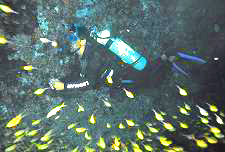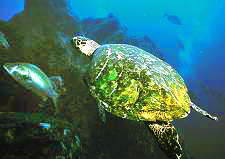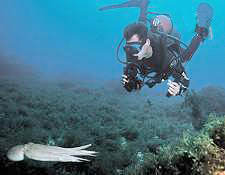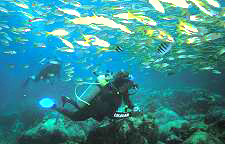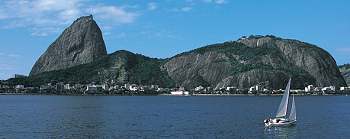
By Denise Mattia
From the Beaches
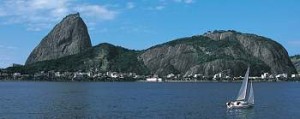
There’s more to Brazilian diving than shallow rivers and deep caves, as Denise Mattia discovers when she takes time out in its coastal resorts
When high humidity and temperatures spike 35˚ in August, the old undertow becomes a rip tide and tells me it’s time to dive off the soot that clings to my skin. Winter in Brazil, offering happier climes and several dive destinations, seemed the perfect answer to the tug at my feet. Motivated by escapism, I concocted a schedule that included dive sites along the coast, inland caverns and an archipelago off shore. I then set out for Rio de Janeiro on a scuba adventure in the largest country in South America.
Lively, warm, sunny Rio is a cosmopolitan city with a daisy chain of grand hotels and wide avenues, an easily reachable racetrack, a cultural center and great food. It’s a city of roughly seven million people who call themselves cariocas and who’ve an argot all their own, a city of traffic jams, football fields and beaches with long boulevards, where a swirl of stylish humanity gathers, jogs, bikes and power-walks. Rio’s temperate winter temperatures brought everyone outdoors.
Gusts in the Atlantic, however, sent waves rolling into the coastline and prevented boats from leaving the
marina. The scuba trips I’d planned to the nearby islands of Angra dos Reis were cancelled daily. Still, there was a city to see, and, when the sun dipped behind Sugar Loaf Mountain, I found myself supping lightly at an outdoor cafe (a necessity in a city where dinner is generally consumed after eleven) and joining the crowds of cariocas at night.
I then took time out inland to visit the incredible Bonito region and dive its rivers and caverns, before flying 1500 miles north to the craggy, volcanic offshore region of Fernando de Noronha.
I awakened at dawn to the sun winking through the window of my room. Outside, a pinnacle rose straight up like a Chinese carving of a mountainside in jade. The serene plains over 1,500 miles away were
radically different from this northern craggy, volcanic region of Fernando de Noronha. The archipelago, a Pernambuco State preserve under the auspices of IBAMA, is renowned among divers in Brazil for the marine life found at reefs surrounding the 21 islands.
Since boats visit the southern (windward) side of the islands during summer when prevailing winds are calmer and the tranquil leeward side in the winter, any time is good to dive here. I signed up with Atlantis Divers at dos Remédios, a tiny 18th Century Village, and by noon was on my way to Hell’s Gate.
As if to welcome me to its portals, a spotted eagle ray winged in for an
encounter close enough to be an embrace. Surprised by the visitation by otherworld inhabitants, it soared into the distance. The usual background for encountering eagle rays and manta rays as well, is the island’s volcanic rock that plunges below the waterline. I finned down past the algae-coated slope to fractured bald obsidian blocks, where an octopus tried to camouflage itself in a vain attempt to hide from my strobes. A green moray eel, the size of a wet-suited leg, peeked out of a pile of rocks to see what was causing a ruckus. The ledge bottomed out at 60 feet, where sting rays lay blanketed in sand. Suddenly I was engulfed in a school of silvery grunts that numbered in the hundreds. They opened and closed ranks around me as if I were a lump on a block.
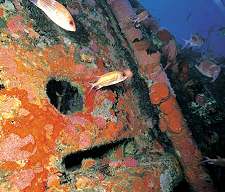
Red soldierfish blend into the colourful backdrop of encrusting sponges on the wreck of the Corveta va Ypiranga, a 60m dive at Fernando de Noronha.
A marathon diver might do this and the neighboring site, Hell’s Hole, in one dive, but with Luciano Saraceni slowly guiding the small group, we dived them back to back. Schools of grunts, coneys and tangs marked the entrance to the grotto, an ancient lava flow that had cooled to a black cavity. Inside the velvet darkness, hundreds of grassy sweapers flicked like yellow explosions from an inferno.
After a day’s diving and climbing up a hill to Forte dos Remédios, which affords views of several stunning beaches below, I didn’t succumb to the temptation to call it a day, but entered the night life zone at Ilha do Morro de Fora. The tiny island near the port is home to Caribbean spiny and Spanish lobsters. Out they came from their slots, unfazed by torches pointing and strobes flashing. If only the flying gunard behaved in a similar amicable manner! It outguessed my every maneuver on the sandy bottom, and I ended the dive knackered, without one image of its huge iridescent blue pectoral fins splayed like a
splendid fan.
I repeated the dive at Hell’s Hole with Noronha Divers, enjoying almost the same presentation. This time an equal number of yellowfin snapper passed among a school of grunts, in that amazing way that fish have of gracefully managing traffic – without colliding. They got themselves sorted out, with the grunts remaining stationed at the site and the snappers disappearing into the blue. Having observed the scene, I could only wonder what the confluence was all about.
Our dive master knew exactly where to look for nurse sharks at the site, North Point. We found one under an incline and a pair of hawksbill turtles on the grassy slope above. Although only green turtles come to the island from December through May to

Unfazed by the lights, lobsters crawl out from under their rocks on a night dive
Cave diving by Martin Farr
lay their eggs, Project TAMAR/IBAMA (The Center for Conservation and Care of Turtles) works toward protecting all species of turtles. Our hawksbills were visitors to the reef in search of food; they weren’t in the least intimidated by the shark or by us.
Frequently eluding humans, spinner dolphins swim close to shore at Baia dos Golfinhos on an average of twice a day. Although IBAMA has placed this sandy bay out of bounds for divers, “dolphin watch” boats visit the site expecting these little guys to appear on cue. They didn’t, I was told, on the afternoon tours especially, yet I spotted a pod from high up on the cliff one morning while on the nature trail that winds along much of the island. Since a boat wasn’t due for another hour, I suspected their timing was…ah, porpoise-ful?
I added another hawksbill to my growing list of underwater denizens during a dive with Lisandro Alemida, resident marine biologist with the newly formed company, Aqua Claras. At Middle Island a river of small snappers meandered over and disappeared into a labyrinthine mini-tunnel. A school of margates hugged the sandy floor. They spotted us and slowed, keeping pace. We stopped. So did they. When we swam forward, they swam forward. The entire dive could have been spent playing this shadow stratagem, but distraction by an octopus proved that my attention span was shorter than theirs.
Thanks to Trimix and the excitement of again diving the wreck of Corveta va Ypiranga, a Brazilian Navy vessel that sank to 62 metres off the western coast of Cabeça de Sapata, I was on full alert. (To my chagrin, I had been narked using air only when I first dived the site and, for the first time in 20 years of diving, had aborted the dive as a result.) The mixture supplied by Atlantis Divers (19 percent of oxygen, 25 percent of helium and 56 percent of air) allowed Luciano Saraceni and me a bottom time of 15 minutes without worrying about nitrogen narcosis. I got a quick look at a two-metre goliath grouper (formerly known as jewfish), which lay placidly near the hull on the sandy floor, and the fly bridge, a colourful kaleidoscope of encrusting sponges and blackbar soldierfish.
The largest concentration of both coral and fish was at Two Brothers, where schools of jacks, tuna, grunts and soldierfish seemed to fill the water between the small islands. I found myself swimming in a fish chowder with moray eels streaking through it. Years ago I foolishly stifled a yawn when I saw great quantities of reef fish. Yet, since then, over the course of 2,000 dives globally I’ve witnessed how over-fishing and pollution have reduced the population. The abundance of marine life here is the measure of success of a preserved environment. Fernando de Noronha was memorable to the last.
I didn’t return directly to Rio but stopped off at Salvador and then proceeded 60 kilometers north to Bahia’s newest resort zone on the Costa do Sauípe, where I basked in delicious lassitude at SuperClubs Breezes. Scuba excursions are planned for summer (our winter) from there, when the sea is calm and the water visibility doesn’t resemble custard powder in a blender. On the way to the airport, I thought ruefully of the dozens of wrecks in the Bay of All Saints I’d missed, and then happily decided that was all the more reason to return to this beautiful location.
Sexy 60s film star Brigitte Bardot made Buzios an “in” place by declaring it her favorite spot. The village, about two hours northeast of Rio de Janeiro City, has become a destination for national and international tourists since then, yet retains an early twentieth-century charm I found most appealing. I arranged a dive with Kupeu, owner of Casamar Dive Operation on Rua das Pedras, a ramble of streets that expanded during the height of the whaling industry, and subsequently underwent a reinvention by city planners. Restaurants, chic boutiques, a few dive shops and pousadas now line the neat alleys that are cordoned off to traffic.
I’d wanted winter in Brazil and had gotten it, in the form of metre-high swells on the way to the dive site. Still, the old sea legs worked just fine during the 45-minute ride. At Armaçáo dos Buzios I timed a wave and dived into 21˚ water that was green with algae. Below, sting rays, over two metres long, their wingspans close to the shoulder width of the four of us combined, circled and settled on the pebbled bottom. Huge starfish and translucent grass anemones clung to bare rock. Kupeu found a green turtle between boulders, a sharptail and a spotted snake eel, plus a harlequin pipefish as well. There was a particular magic in seeing the whole continuum of underwater life from the northern archipelago to this southern coastal zone.
Delicately colored soft corals and sea fans grow in profusion at sites farther to the south, Kupeu told me. Although I’d planned to spend my three remaining days diving in Buzios, hearing of the rich diversity of marine life that appears on the reefs along the shores at Arraial do Cabo sent me packing and off to what translates as the little village on the cape.
Anyone can see that Arraial do Cabo has grown considerably since it was named, and today the district is half working port and half holiday destination. Jutting into the Atlantic Ocean to the north, the peninsula forms a wide natural harbour that shelters both fishing vessels and oil tankers, which are filled regularly from the Petrobras pipeline under the supervision of IBAMA. To the south are a dozen kilometers of breathtakingly pristine white sandy beaches lined with quaint residences, pousadas and a lovely new hotel.
More than 25 scuba sites circle the peninsula – some are shipwrecks, though most are along the rocky shoreline. Submarine currents, which rise from Patagonia near the South Pole, carry nutrient-rich water to Arraial do Cabo. Known as the Resurgence Current, it’s a caravansary for marine life, attracting whales, crustaceans, mollusks and fish. Yet with this bounty often comes poor visibility and cold water.
With each of my three dives here, the wealth of plankton seemed to increase, finally reducing visibility to under a metre. Water temps dropped from 17˚ to 13˚. Having cut my dive teeth in the Caribbean, I had to admit this was a shock. Yet the experienced eyes of Paulo Lopes of PL Divers, and Sanderson of Arraial Sub Diving Center (and of fellow divers as well) were able to find everything from a sea horse at the site, Ensenada do Forno, to the shipwreck at Ilha dos Franceses. Kupeu had been right. There is a diversity of marine life here – if you can see through pea soup. This area would be worth exploring from April to June.
As I ride in the taxi to the airport and chat with the driver, I put my finger on what, apart from the diving and visual beauty of the landscape, has impressed me about this country. It’s the people. They are healthy, good-looking and hospitable, exuding confidence, grace and charm, using their leisure in the open air, welcoming a stranger genuinely and warmly. Many I met were fluent in English. My driver wasn’t, and my Portuguese consisted of a few words added to rusty Spanish. Still, we understood each other more intuitively than a translator could convey and, at the terminal, he gave me a great bear hug, adding boa sorte, good luck with life. This is Brazil, I thought. Thanking him I replied, Saudades do Brasil. I will miss it indeed.
About Denise Mattia
A writer and photographer, Denise Mattia’s works are published nationally and internationally and include all aspects of leisure travel: art , culture, resorts, spas, food and wine and sports’ activities. She's the founder of the soon to be launched Yum-Yum-Traveler, a site devoted to reviewing restaurants in addition to her travel articles from around the world. She lives and works in Manhattan, where she was born.
- Web |
- More Posts (91)
